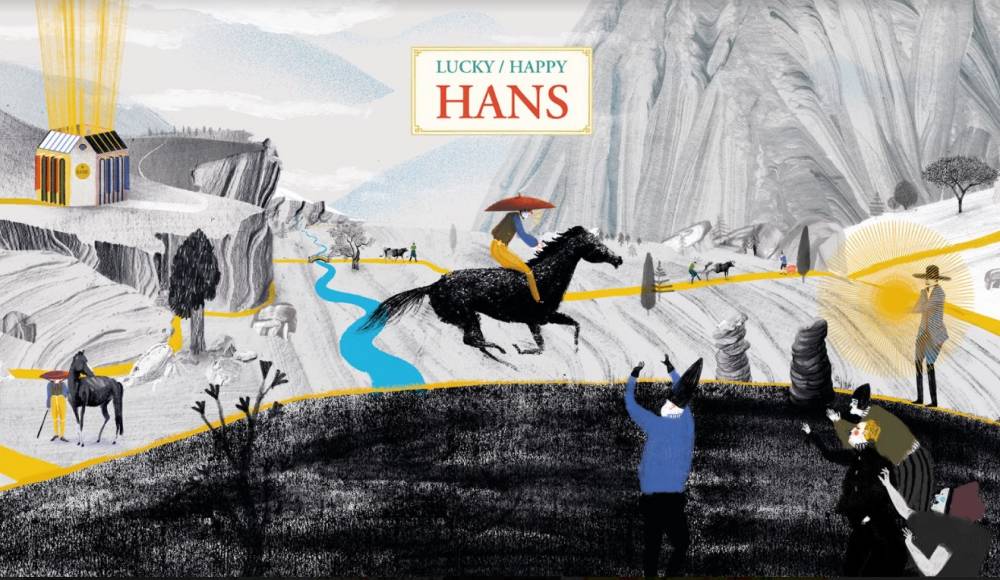
25 Jul Lucky/Happy Hans: Fool or Sage?
by Maguma
Publisher’s Note
We’re delighted to present Lucky/Happy Hans: a folktale by the Brothers Grimm, illustrated by Spanish artist, Maguma. In the well known story, a young man called Hans exchanges his hard earned piece of gold for one object after another, in a series of increasingly unprofitable trades… until he is left with nothing. Surprisingly, he is happy about this. Is he merely naive… or is he wise beyond his years? Our book interprets this classic tale of greed and need for the contemporary reader, in the form of two parallel visual narratives. The Goethe-Institut, Chennai, helped to bring this book out during a difficult period for all publishers, for which we are really grateful.
Our latest title Lucky/Happy Hans includes 4 cards for you to give away, trade, or keep… the decision to make a lucky/happy exchange is yours.
This is our second book with Maguma – in 2016 we published God of Money based on Karl Marx’s celebrated critique of greed and profit. Like many of our titles, this one too was born out of a rich and dialogic collaboration between us and the artist. Our publisher Gita Wolf met Maguma at a workshop in Madrid at the Illustratour Festival 2014. She found his work conceptually strong, witty, and socially empathetic. She wanted to work with him, and invited him to a residency at Tara Books, which was fortuitously supported by the Spanish agency Accion Cultural Esponala. Meanwhile, we wondered what we might offer him, by way of a text or tale to illustrate. Since his talent lay in translating complex ideas into visual metaphors, we went over a series of texts that would lend themselves to this purpose: the poetry of William Blake, fables from Tolstoy, some of Marx’s writings… Finally we settled for extracts from Karl Marx’s early work, the Economic and Philosophic Manuscripts, 1844. These comprised his views on money – viewed by him as an omnipotent and abstract force that confers power and causes powerlessness, generates profit and false needs, and limits imagination and thought.
Maguma was enthused by the text, and came up with a startling visual interpretation that captured the deathly nature of profit-making and its smirking, self-satisfied character. He also designed the book as a series of accordion fold-out pages that simulated the endless and spiralling nature of avarice. Find out more about how God of Money was constructed, in our earlier blog post.
In 2018, Maguma came to us for another visit, again supported by Accion Cultural Espanola. This time, we offered him something very different. The story of Hans, which reads as a classic tale of exchange, but we thought there was more to it: it could well be a fable for our times, when we are no longer sure about what we need, and are caught in a vortex of exchange-driven consumption.
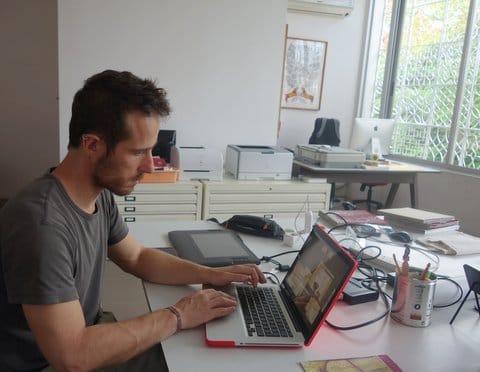
Maguma at Book Building, Chennai
He warmed up to the theme, did his own research on the subject, and came up with an interesting visual concept: he would create two versions of the same tale, one that followed the traditional plot line, and the other a contemporary take which was his own. Even in the first version, he brought in a lot of his own interpretation: following the fortunes of those who cheat Hans, for example. His contemporary story shifted its focus from the physical commodity exchange of the original story to the virtual pursuit of happiness… a quintessentially 21st century obsession. Is Hans a ‘commodity fetishist’ or is he looking to exit a world of increasingly opaque, if not false needs?
When Maguma completed his visual story, our editor Divya Vijayakumar came up with text for both versions: enigmatic captions for the original tale of exchange, and mock instructions from an ostensible video game for the modern version. Gita Wolf added another layer of complexity to the project, by going into the original German title of the story — Hans im Glück. The word translates both as luck and as happiness — and perhaps gives a clue on how we could interpret Hans’ delight when he loses everything, in the original story. Is he a simpleton, which is one reading of the story — or wise beyond his years, knowing the true basis of happiness? Or can he be seen as a product of changing times, caught between a society used to barter, which was slowly shifting to an economy, given over to profit? Gita Wolf explores these and related issues in two suggestive short essays which provide the context and link the two versions of the story. These ideas are behind our naming the book Lucky/Happy Hans, to indicate some of the complex ambiguities that led Maguma to set out on his own creative journey of interpretation. We leave you to draw your own conclusions on what motivates Hans.
Flipthrough video of Lucky/Happy Hans
Maguma’s Journey
I remember the moment when I received the proposal from Tara Books to work on what became Lucky/Happy Hans. I was very excited with the idea of collaborating with this incredible team again. Also, the idea of traveling to Chennai and being part of the daily life of Tara’s team appealed to me enormously. Thanks to Accion Cultural Esponala, who had also supported my first visit to Tara Books, I was soon on board a plane and all ready to stay and work at Tara’s Book Building for two months.
Working with Hans in Luck, which exists in innumerable versions (some of them beautifully illustrated editions) posed a huge challenge. But I was also excited and quite delighted, for the mercantile atmosphere of this wonderful Brothers Grimm fable reminded me of God of Money.
I like to start all trips and projects by sketching. On this occasion too, I did the same. My impressions of the trip and my drawings for the Hans story were mixed together in a single sketchbook that I later had to dis-assemble, as I got into the book project. But, initially, this is what I had in the travel parts of my sketchbook:
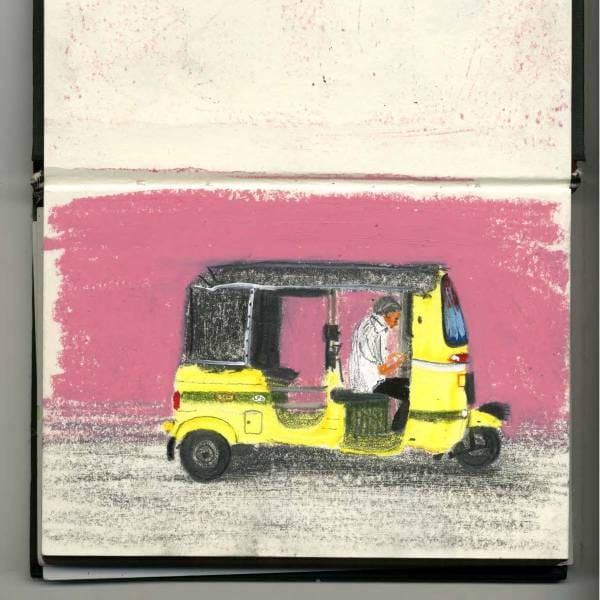
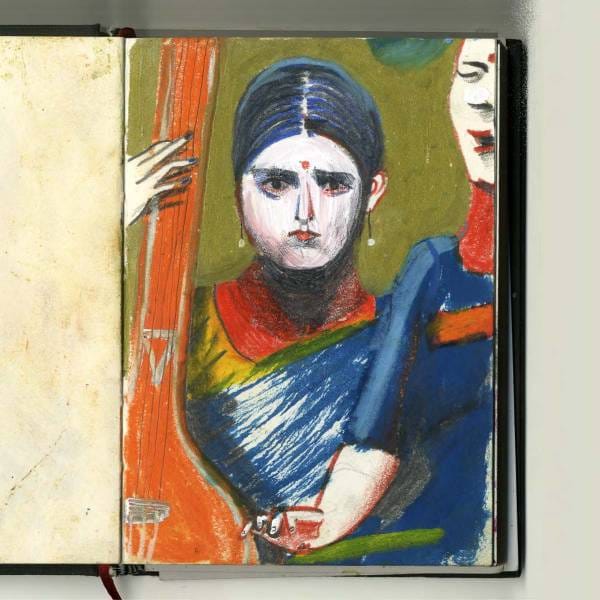
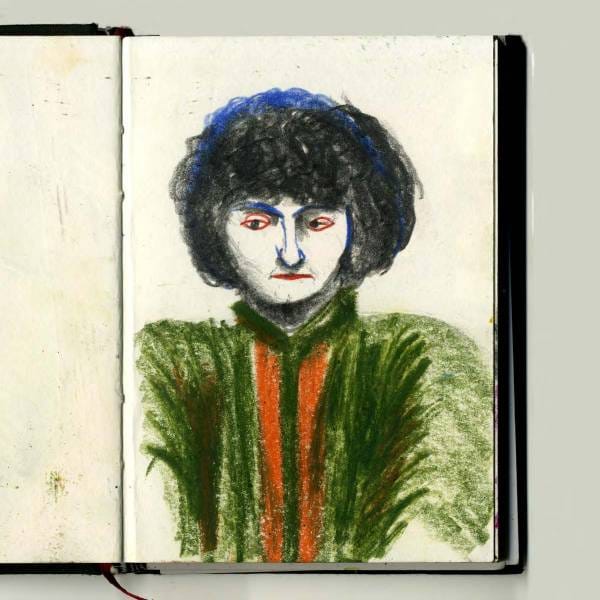
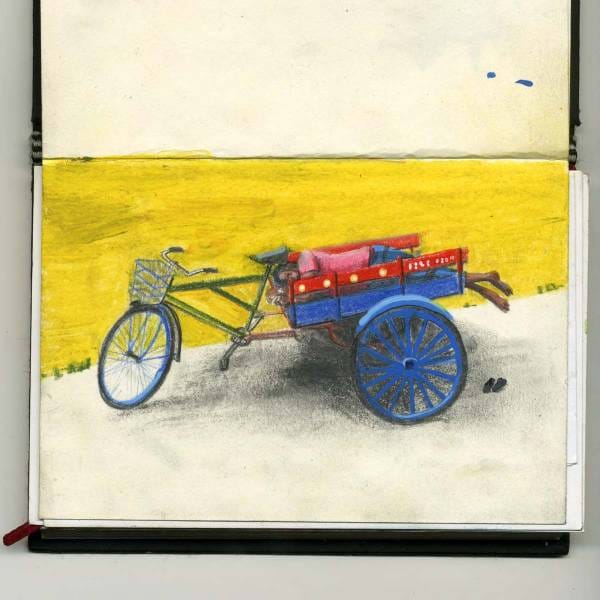
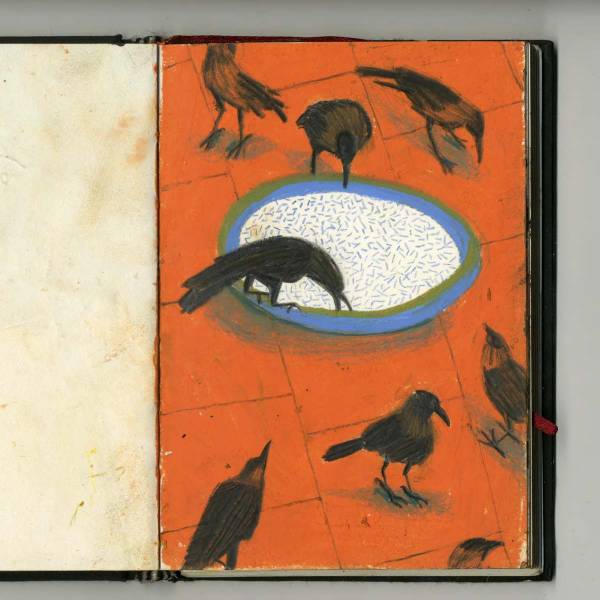
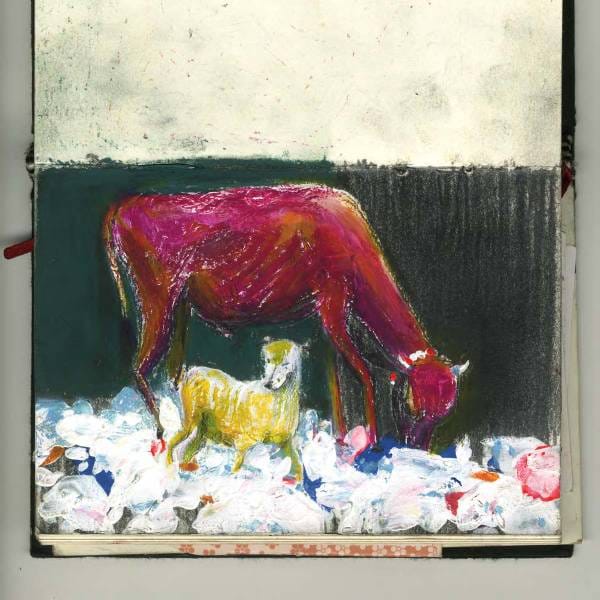
Maguma’s Chennai sketchbook, 2018
I spent my early days in Chennai researching other versions of Hans in Luck, following the leads that I had and also working my way through the internet. The more interesting ones opened my eyes to the many possible approaches I could adopt for this project.
The first thing that struck me was that in many illustrated versions the whole story is represented as a single continuous image. Even in profusely illustrated versions made up of multiple pages, at some point, the entire whole story is presented through a single image, which opens out as a marvelous map.
It’s striking that while these versions work with different aesthetic elements, they all focus on the same and often repeated fact of the story: the exchange of goods.
In the versions illustrated by Walter Crane and Oswald Poetzelberger, both of which were produced in the heyday of capitalism, the economic value of goods is expressed by gradually reducing the size of the goods in a downward direction. The enigmatic Hans also appears on covers of some editions and a few of these caught my attention.
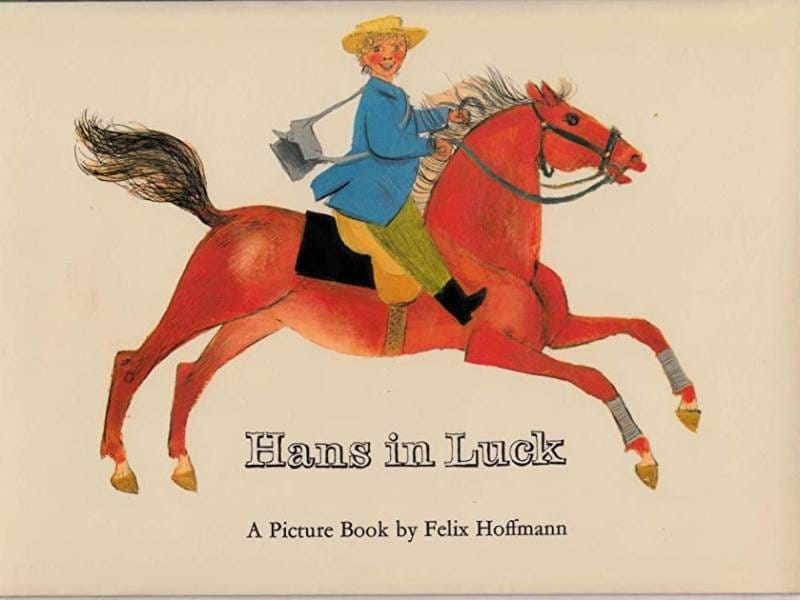
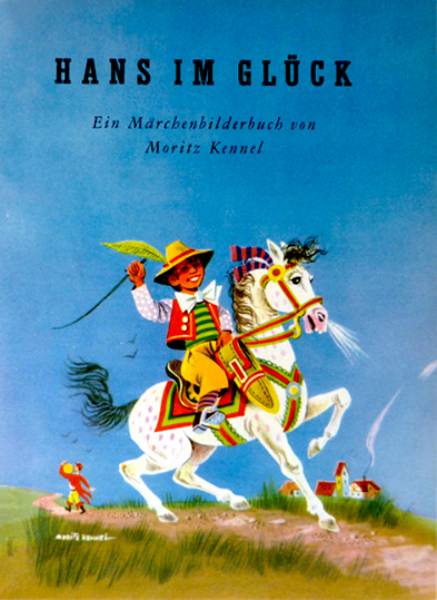
Hans im Glück, illustrated by Felix Hoffman on the left (Public Library) and by Mortiz Kennel on the right (Grimm-Bilder Wiki)
Hermann Woehler’s cover is interesting because even as it lists each of the goods that is exchanged, it foregrounds Hans, who is shown to be a veritable madman. Marlene Reidel’s depiction is also unusual: in her cover image, it is not only Hans, but the yellow path of the journey that is equally the protagonist of the tale, an idea that is also implicit in at least one of the map-images which I have referred to above.
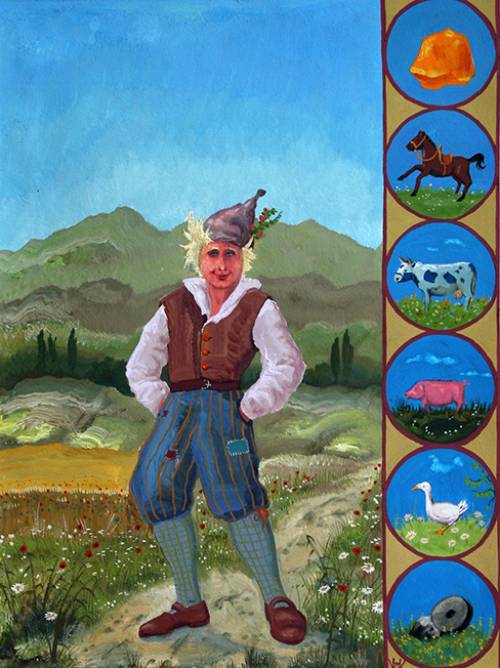
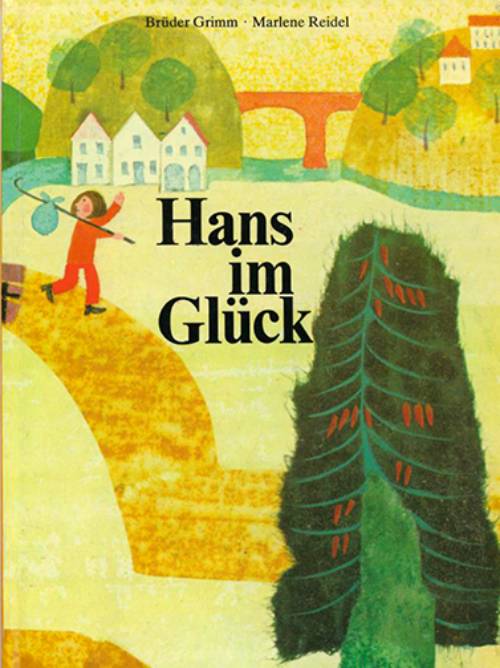
Hans im Glück illustrated by Hermann Woehler on the left (Grimm-Bilder Wiki) and by Marlene Reidel on the right (Grimm-Bilder Wiki)
Famed illustrator Shaun Tan has created a print, titled, Lucky Hans. It features a determined Hans, with a golden head, all set to walk through a long path of pointed nails. A rather clever way of showing the difficult circumstances of his journey.
In most of the versions that I reviewed, the story goes the same way: Hans is presented as a poor deluded man who hasn’t understood anything about the value of things. But all of them also gesture towards a hidden enigma that no one questions. Is Hans really crazy? Or is he, perhaps, totally conscious of what he is doing?
An exhibition on display at the Goethe-Institute in Berlin in 2015 – featured reactions to the Hans story from around the world. Some interpretations were resolutely materialist: they held that the story featured transactions that were in the nature of a barter, and therefore, a world where it was not possible to establish an equivalent relationship between the various objects. In other words, this was a world that was not bound by the law of universal exchange, or its form, which is money. There were also simple and straightforward readings of the story, by 12 year olds, including a charming one from the Philippines! But the version that caught my attention was one that portrayed Hans as a Taoist sage in search of complete happiness, over and above material goods. From that moment onwards, the meaning of the story was transformed in my head.
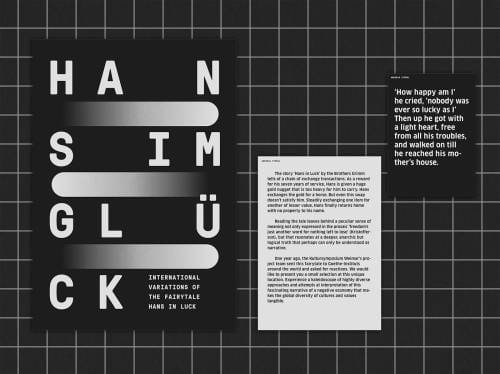
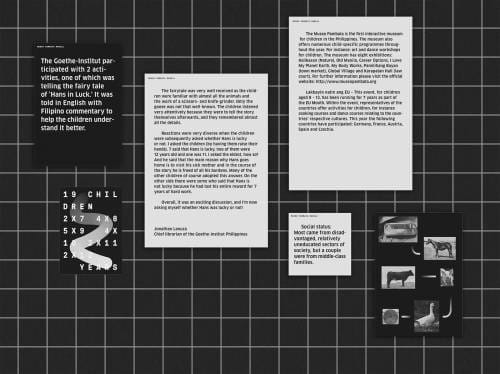
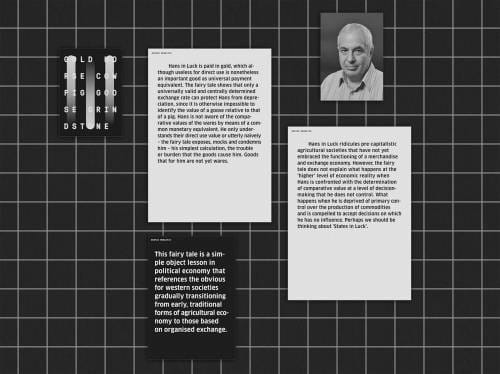
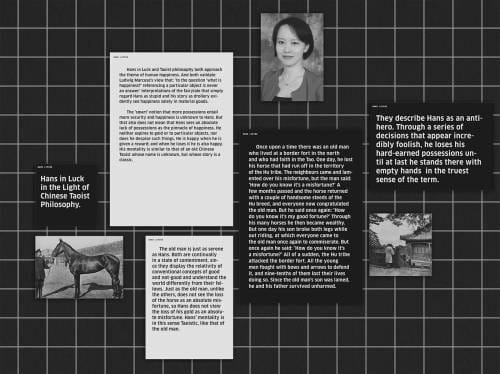
After I had reviewed various versions of the story, I began drawing. I started with all the characters that Hans meets. I also ended up drawing their possessions, the objects that they trade for whatever Hans has.
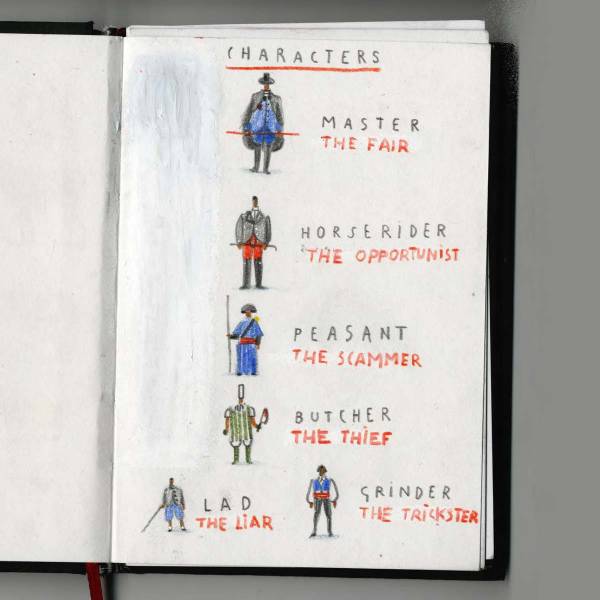
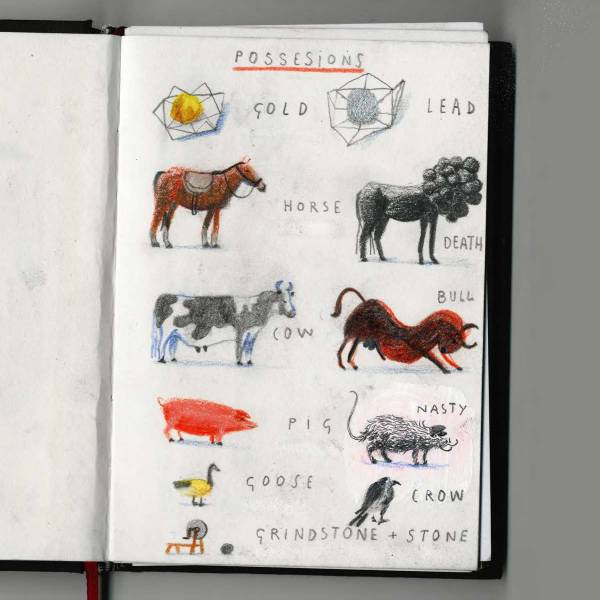
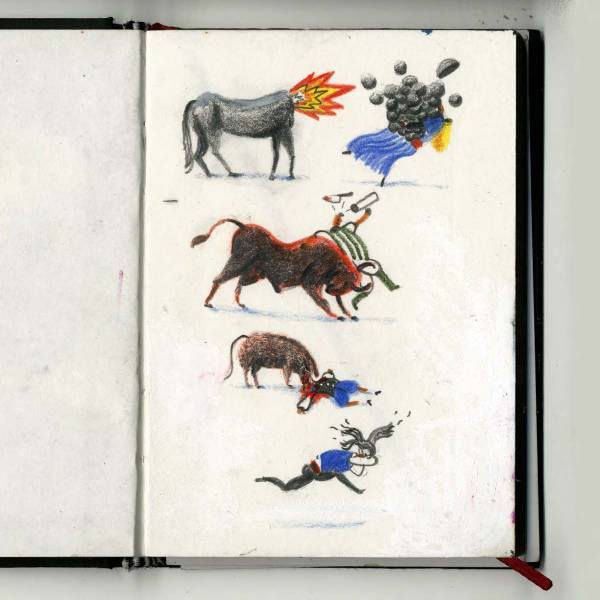
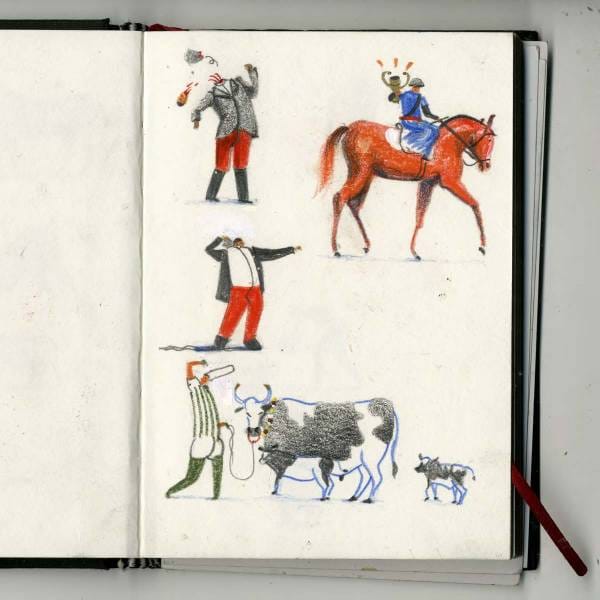
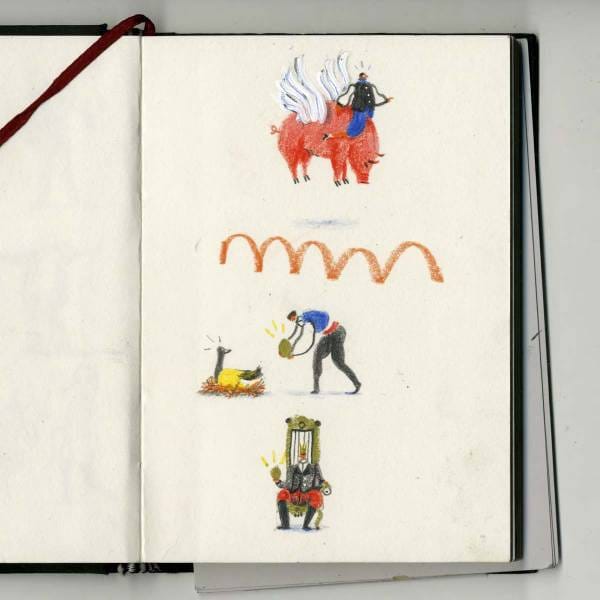

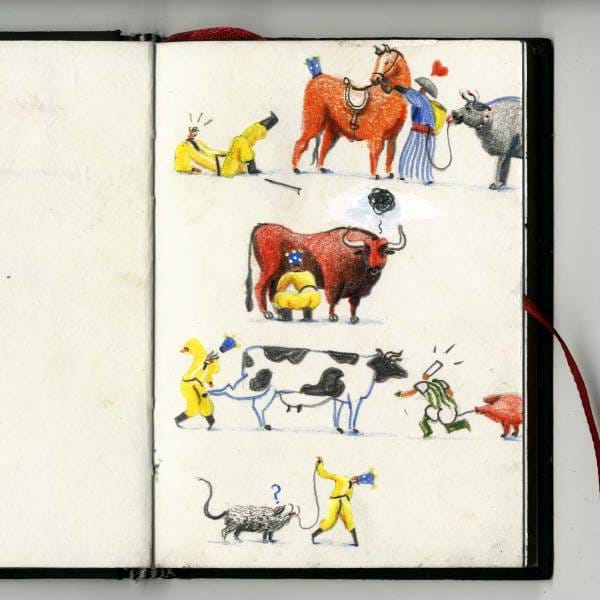
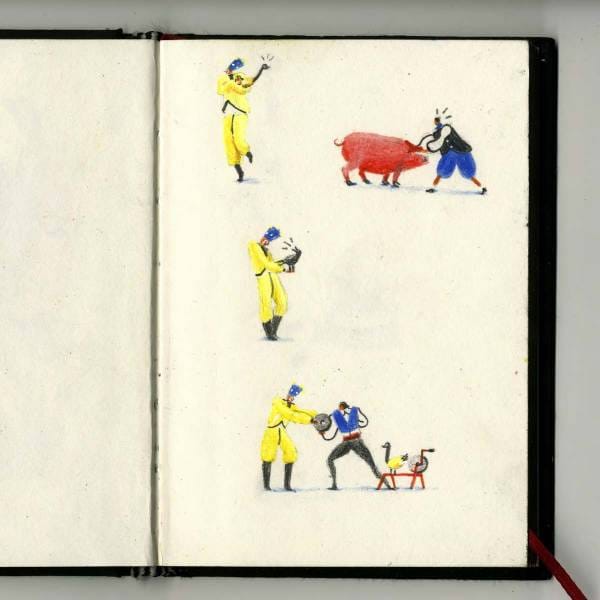
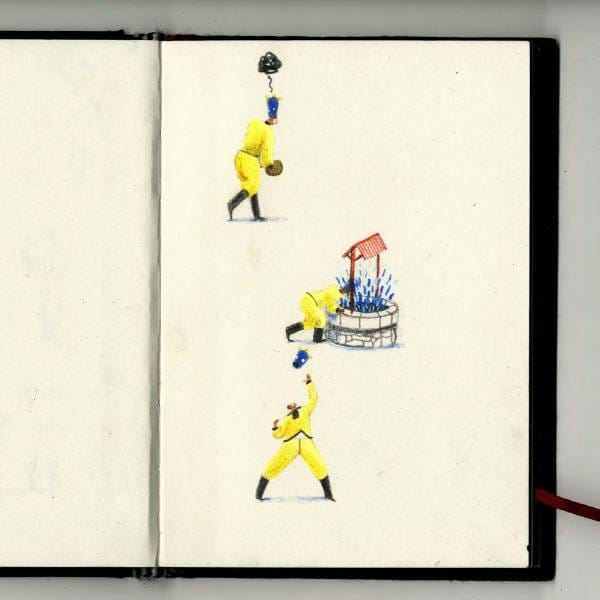
Initial sketches for Lucky/Happy Hans
In these initial drawings, I viewed these objects of exchange, from two perspectives: not only Hans’, but also of the secondary characters who trade things with him. To me there seemed to be two aspects to the exchange process, one positive and the other negative. In some cases the object that was acquired from Hans resulted in good fortune for the secondary character in question, whereas in some other cases, it led to misfortune. I also drew the moments of exchange, like other illustrators had done.
Using these drawings, I gradually built a visual map in which I tried to represent all the possible interpretations that the Brothers Grimm story had for me.
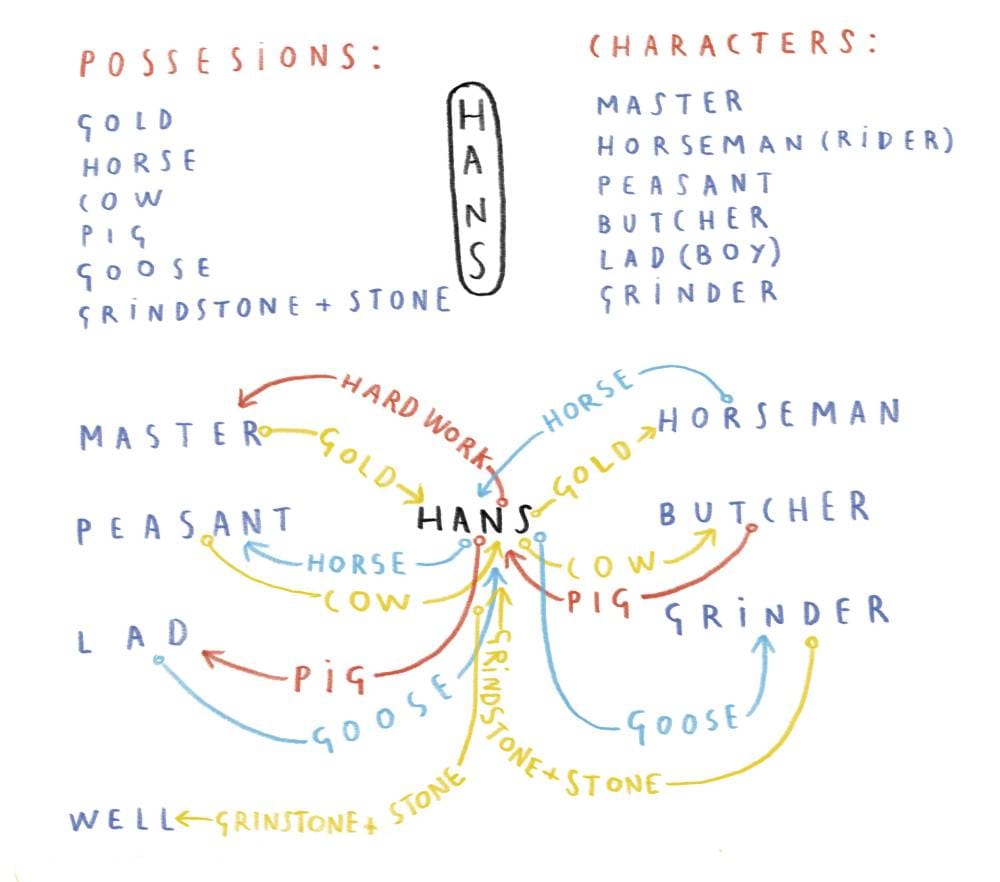
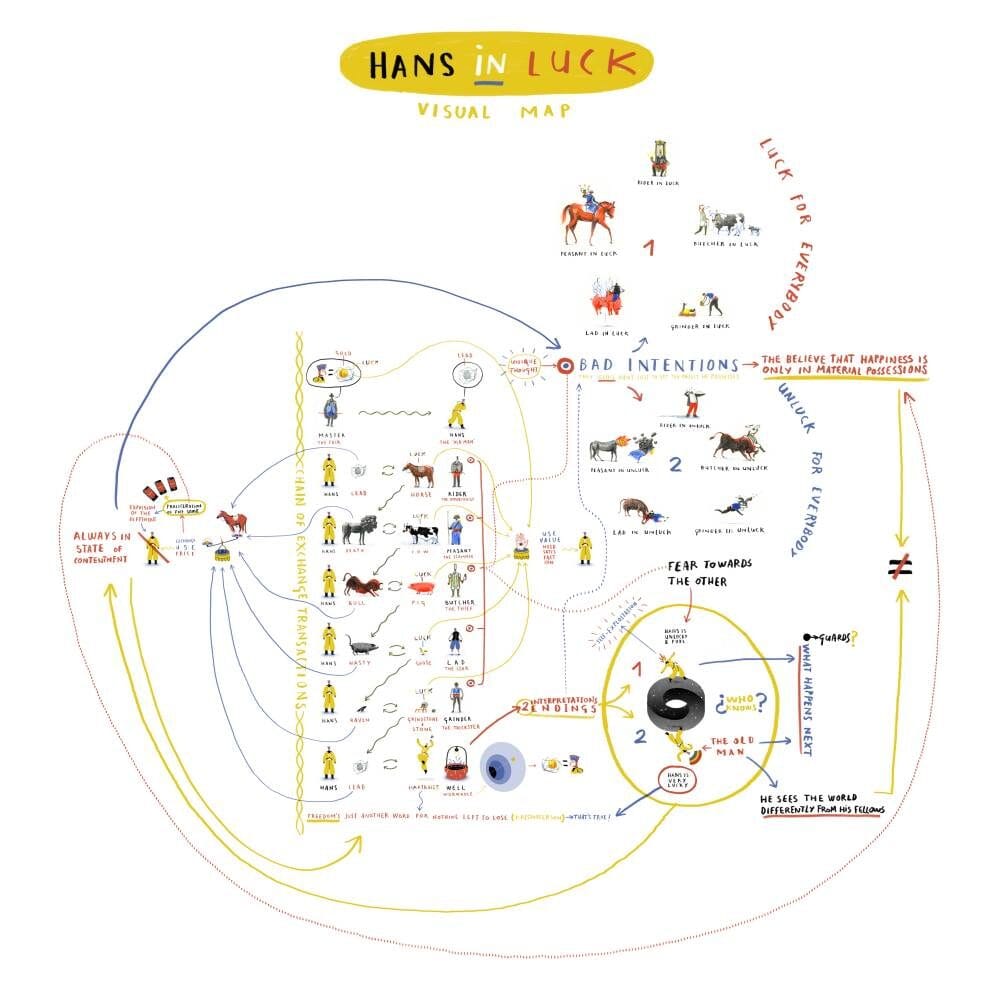
Visual maps developed for Lucky/Happy Hans
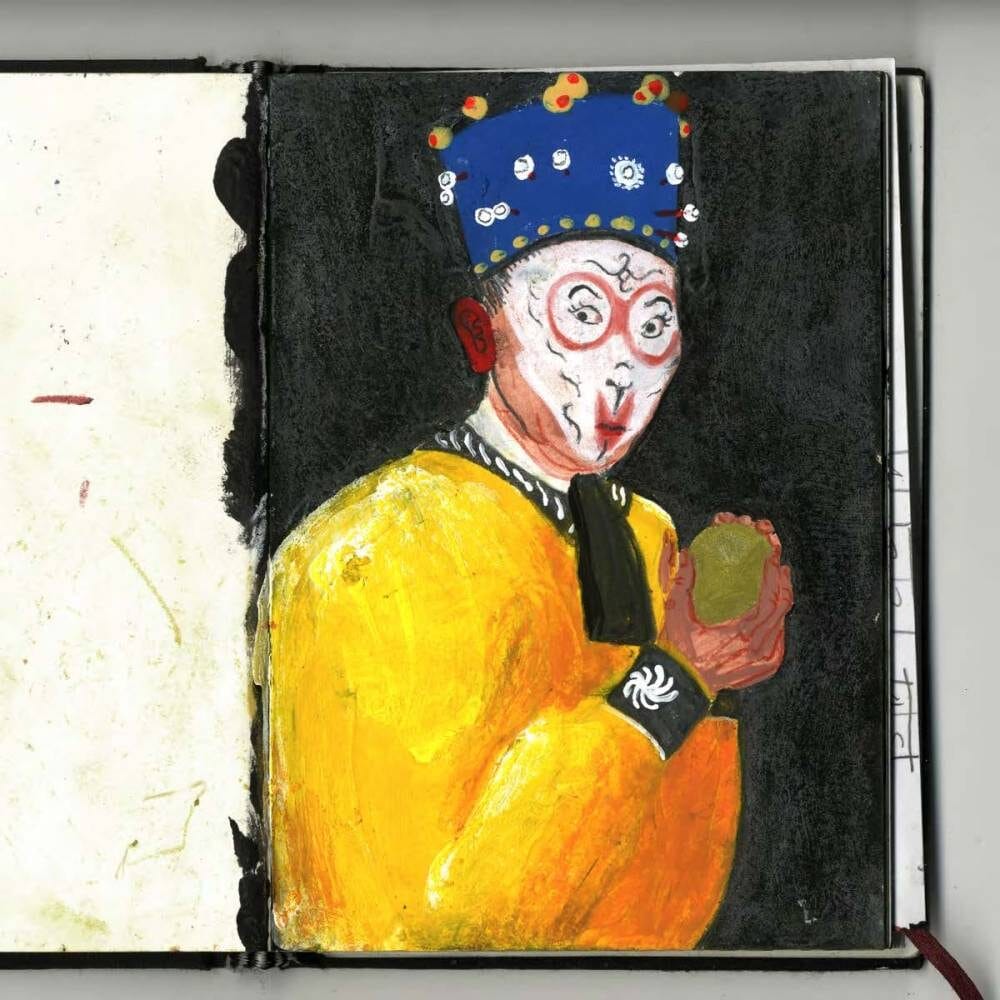
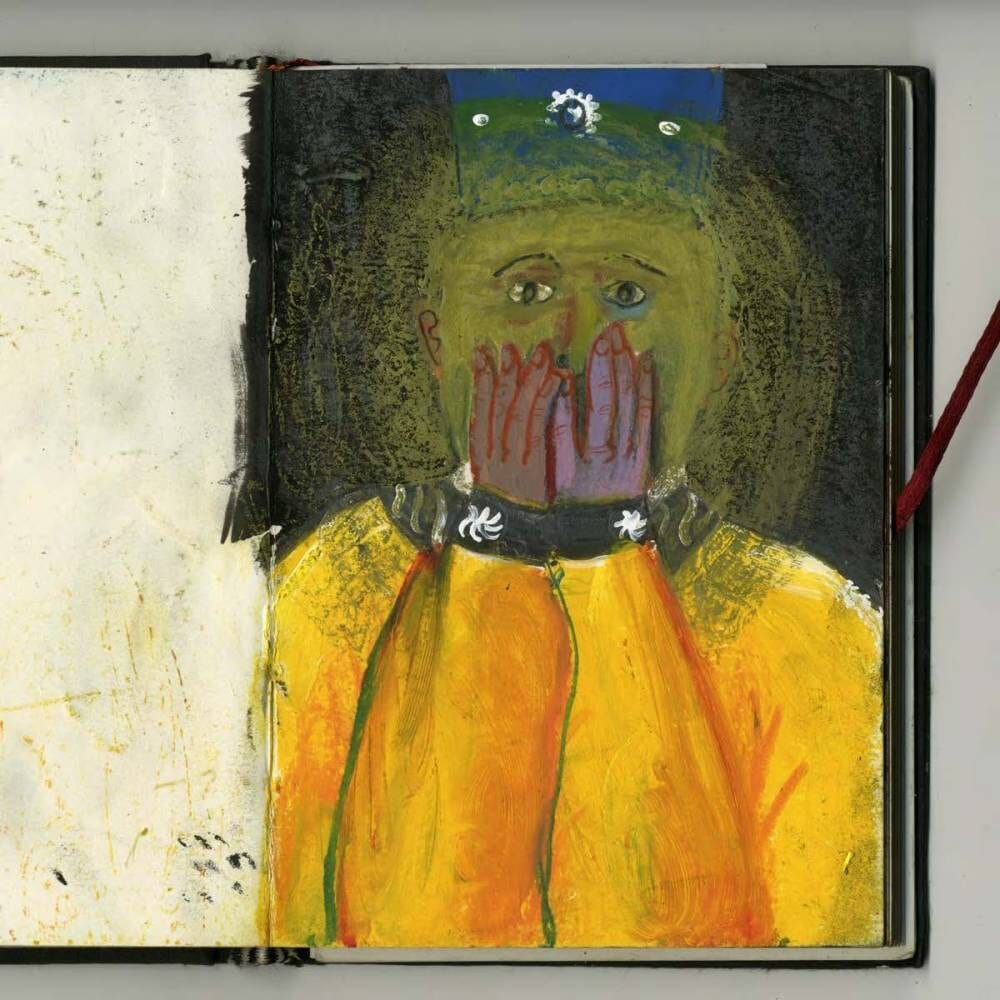
Initial sketches of the protagonist for Lucky/Happy Hans
However, I was still unclear about my central character: was he delusional, a disturbed man, or was he a philosopher, if not a sage? To clarify my dilemma, I found myself turning to the work of the Chilean Spanish film-maker, Alejandro Jodorowsky. He had looked to the symbolism of the tarot cards, to make psychological sense of the world, and also for creative inspiration. It seemed to me that my idea of a double interpretation of the central character in this story mapped nicely to what he had attempted to do with the tarot.
The tarot deck consists of 78 cards. Each card is supposed to hold an arcana, or a secret. When read and divined in particular ways, the cards, it is believed, help to make sense of one’s life, clarify one’s dilemmas. . There are 56 minor arcana and 22 major arcana. The minor arcana stand in for everyday life and happenings, while the major ones symbolize rites of passage and life events. For Jodorowsky, the arcana were not so much insights into the future, as they were ways of understanding the present.
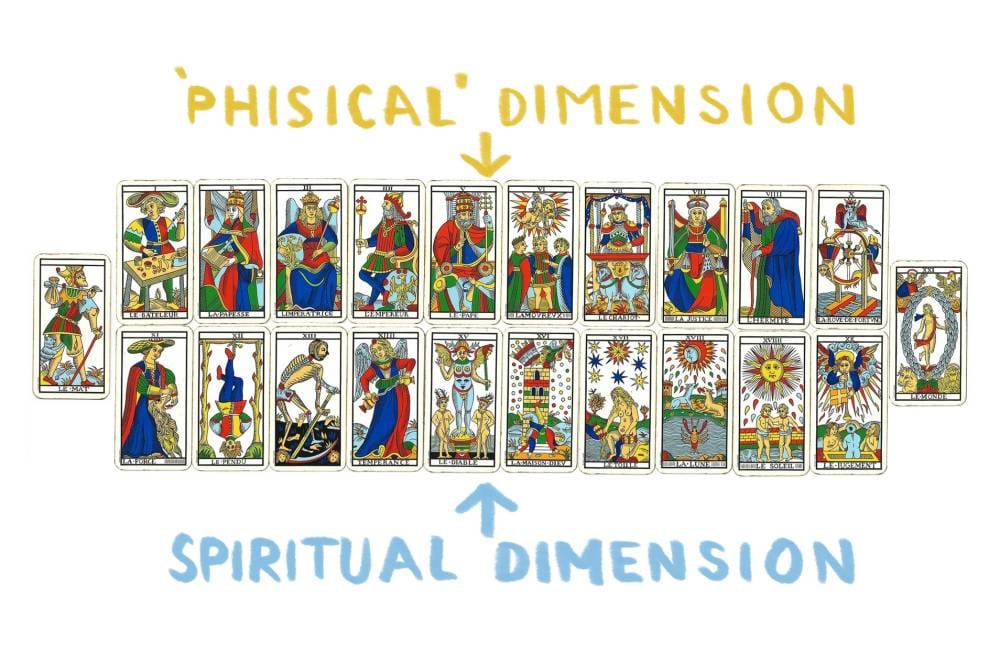
Tarot card sketches for Lucky/Happy Hans
To explain the general meaning of the major arcana, Jodorowsky arranged the 22 cards from the Marseilles tarot (which is one of the more widely known tarot decks), in two parallel rows of ten cards each. The rows represented the two dimensions of the initiatory journey of knowledge that a human being might yet undertake: the physical and the spiritual. There are two arcana that are outside these two dimensions: The Fool, which, unlike the other cards, does not have a number and The World, which is marked with the number XXI.
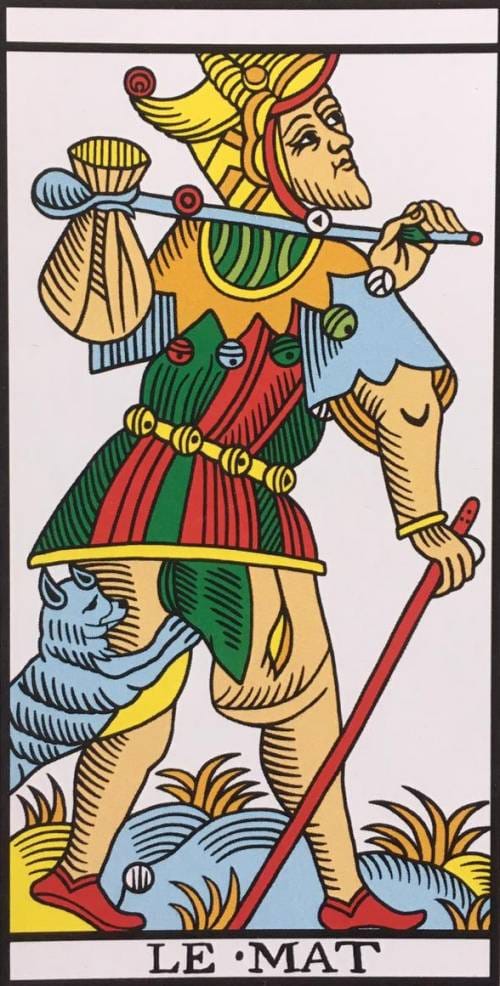
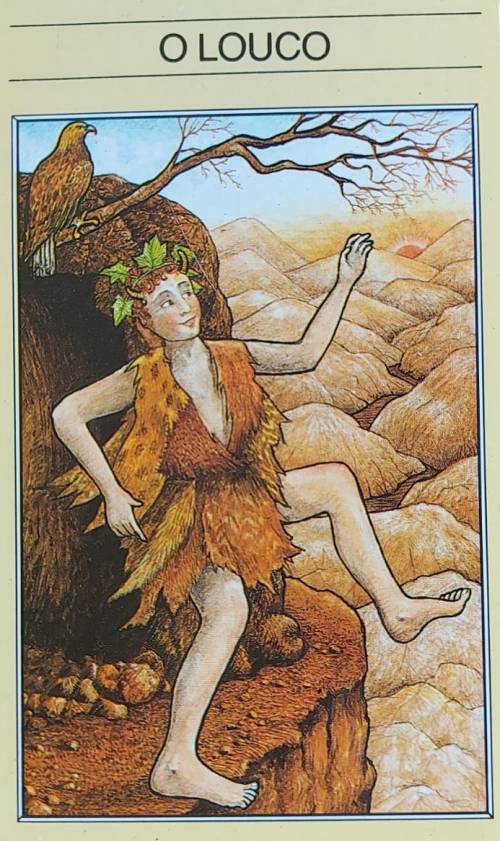
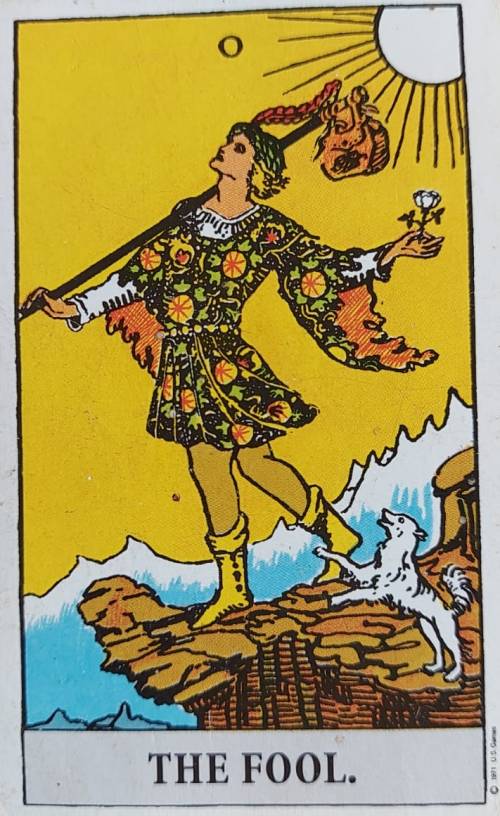
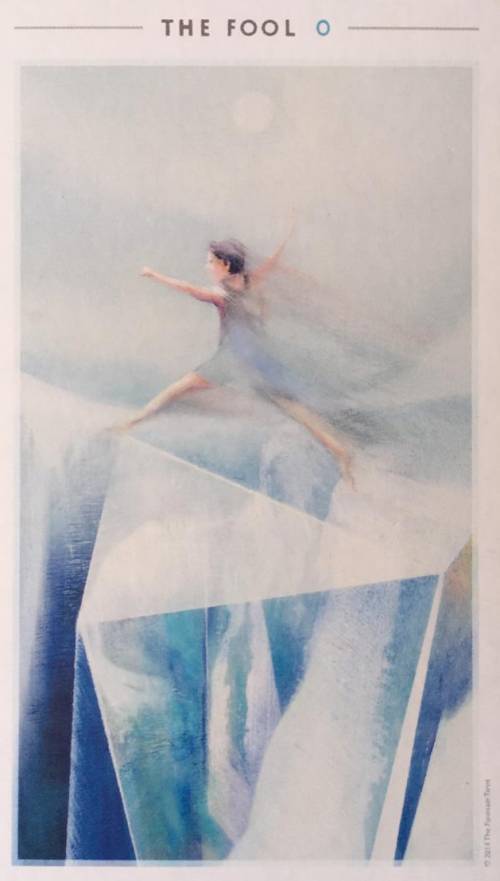
The Fool cards from Maguma’s tarot card collection, the first one is Alejandro Jodorowsky’s version
I could not help but see a certain parallels between my narrative and Jodorowsky’s reading of the major arcana. Hans was the Fool of the tarot. He sets off on his journey, creating a path for himself. However, he does not seem to know what he is looking for. But as he goes along, he comes up against the World, and he has to find his way through it. At one level, he engages with it in a materialist sense, and trades a series of goods. But at another level, he is also letting go of each object. Whether this is by chance or luck, or because he genuinely wishes to do so, we don’t know. But finally, he finds himself without any possession, and heads home, empty-handed and free. To me, home appeared not just a physical place, but an idealized destination, where one might find eternal happiness, and I wanted to ponder over this.
Trying to construct all of this visually, I was faced with the challenge of representing the two different but connected ways of thinking about Hans. Whether we see his journey as physical or spiritual, or both, it is the path that stands out. So I turned it into a visual motif, and made it the protagonist of the tale. Meanwhile, I had decided that I would tell this story from two times as well, the past and the present. This meant that the story had to move spatially, and across two different landscapes.
Once again I turned to the accordion book form (which was what I had worked with, for God of Money) so that I could extend Hans’ journey in both space and time.
Also, this form would allow me to show Hans’ journey as one continuous image – my tribute to earlier and what to me are the classic visual representations of the story.
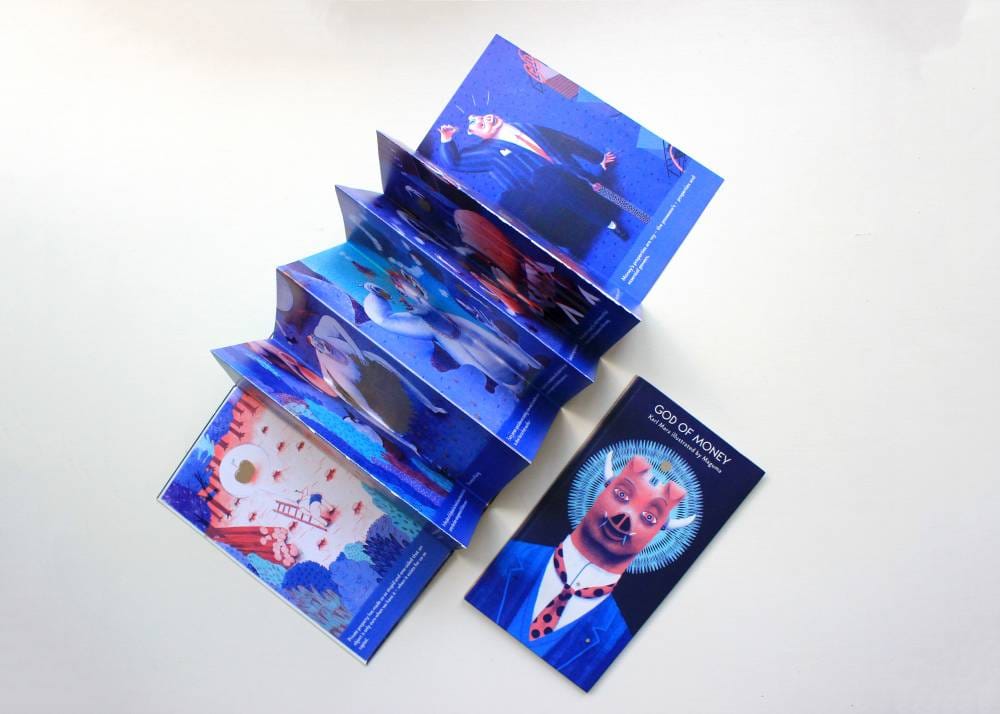
God of Money an ‘accordion’ book
I felt that Hans in Luck was gesturing towards God of Money, not only in terms of form, but also, content: both texts had to do with the moral consequences of exchange, whether undertaken as barter or as commercial trade.

The storyboard for Lucky/Happy Hans
The next step was to create appropriate landscapes through which Hans travels: I decided that I would evoke time past by setting the story in a natural landscape, with mountains and rivers, and which would retain the fairy-tale quality of the original tale. For the other version of the story, set in the present, I decided to create a dystopian urban reality with clear references to our contemporary world. In order to retain visual unity between both parts of the narrative, I sought to develop Hans graphically, so that he could credibly occupy both worlds.
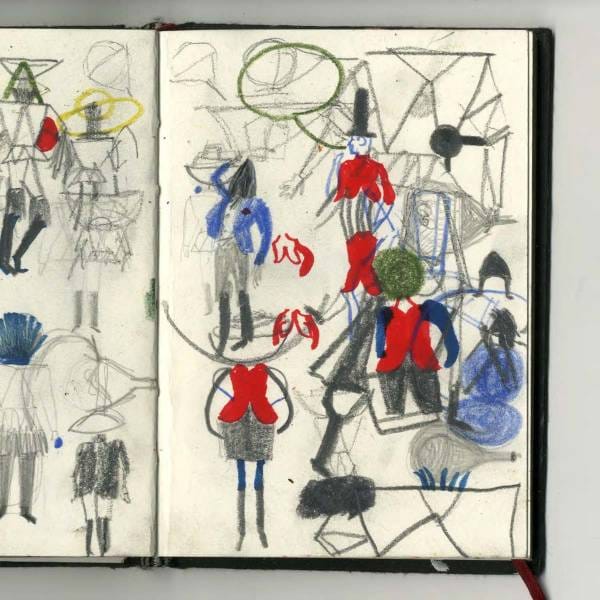
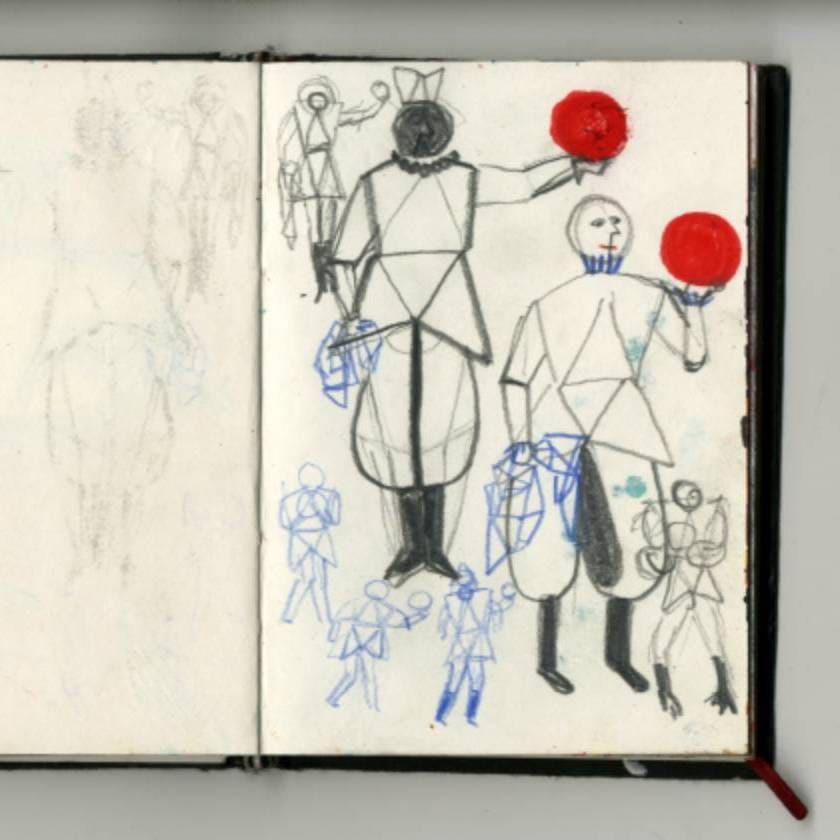
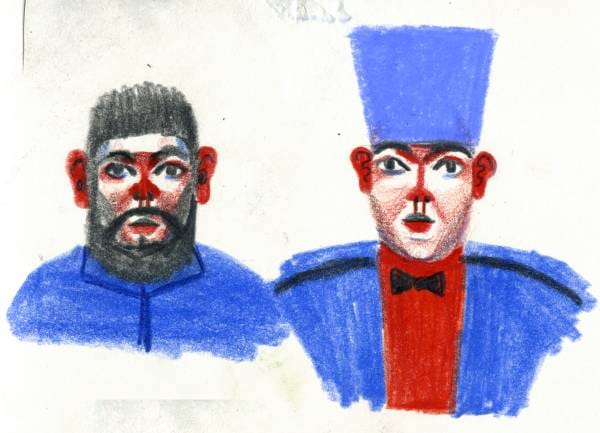


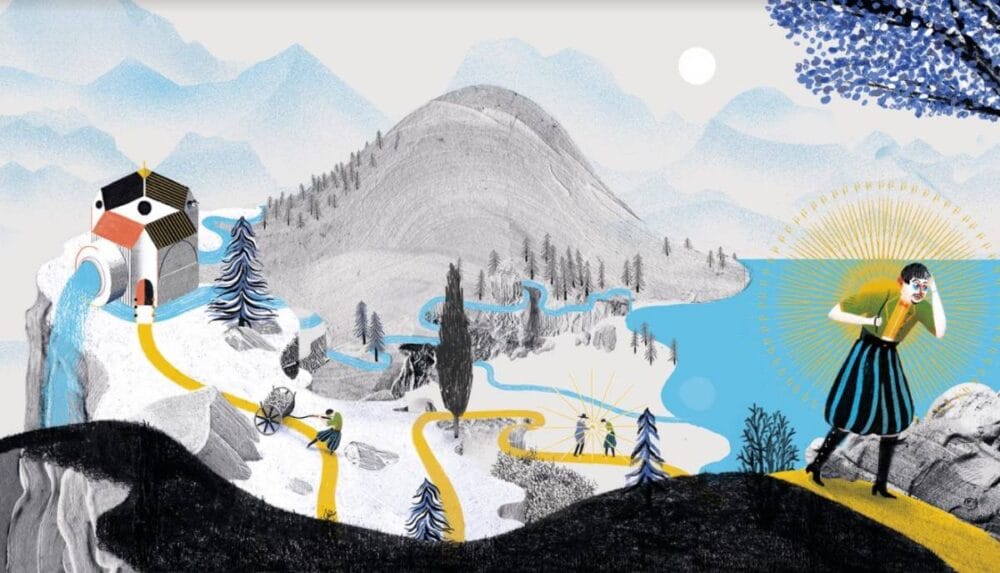
Character sketches and final illustration for Lucky/Happy Hans
Gradually, I scanned the images in my sketchbook, and used these to make a digital collage that would help me map the first – fairy tale – journey. I retained my initial idea of depicting the fate of the secondary characters in the story, and since the layout was open and continuous, I could build on the collage, adding more and more visual information.
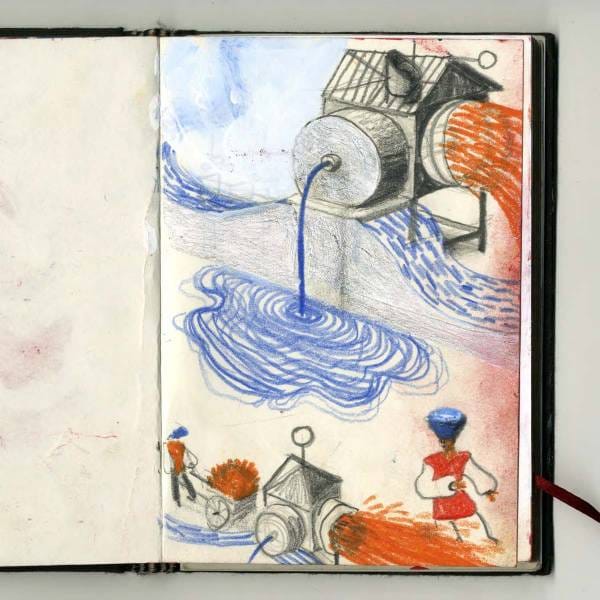
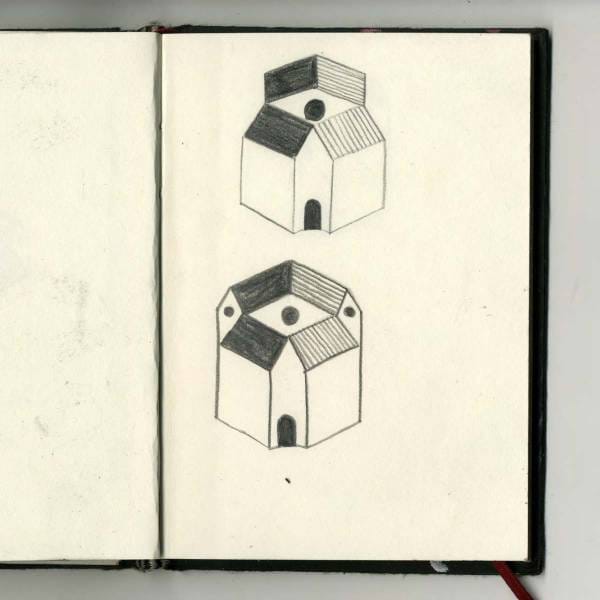
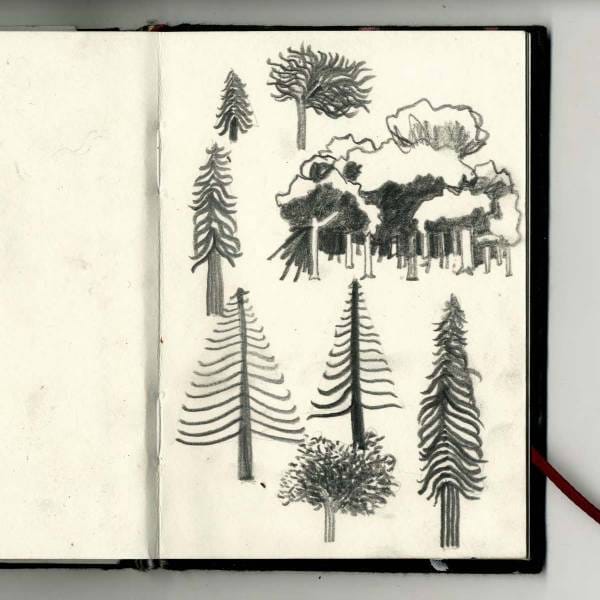
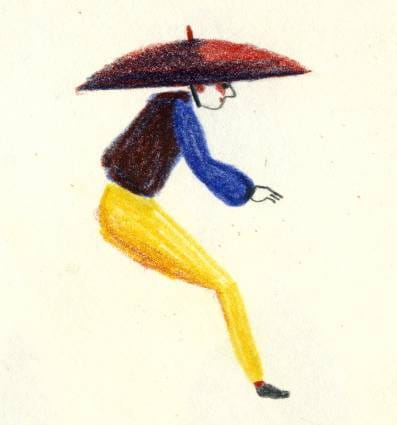
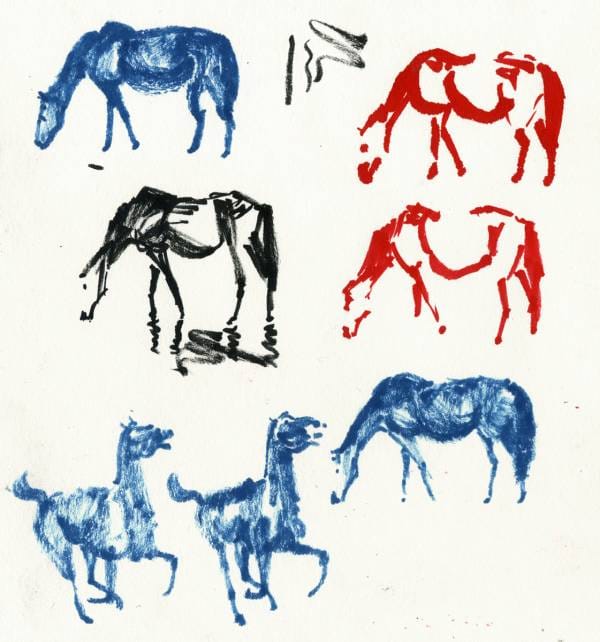
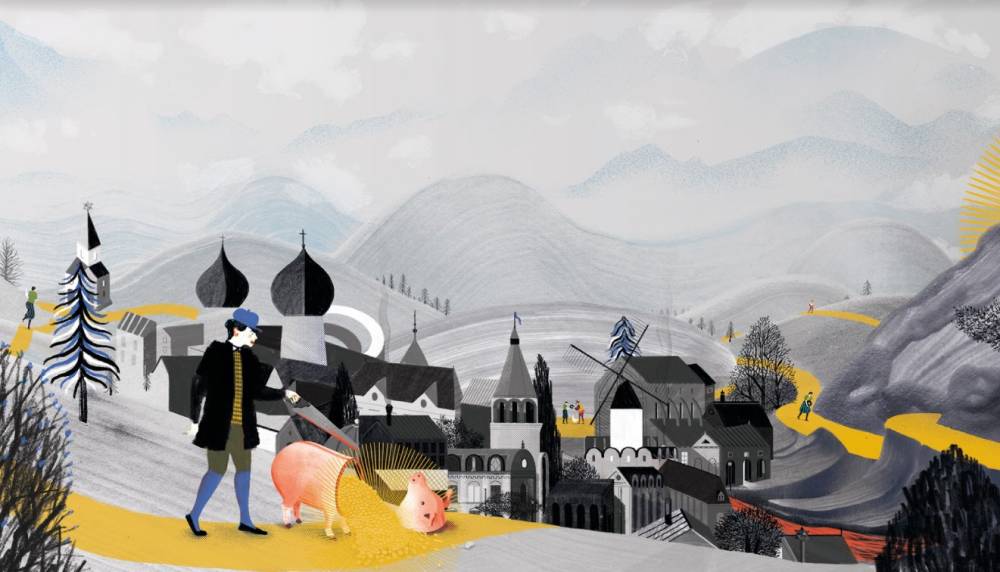
Scene sketches and final illustration for Lucky/Happy Hans
When I was done, I had before me a long continuous scene, rich in texture, with an abundance of gray tones punctuated with splashes of intense colour – which ends at a blue door, presumably the entrance of Hans’ home. But of course the story does not end here, and you flip the fold and find yourself in a second story.
For this second part I had envisaged a dark urban atmosphere. I referenced the work of John Hejduk, Vladimir Tatlin and M. C. Escher to create the surreal forms I wanted. When they were complete, my drawings were in Egyptian perspective, and clothed in colours that were very different from those that featured in the first half of the narrative. The landscape of the story had turned electric and obsessive, reminding one of an oppressive video game that Hans wants to exit, at any cost.
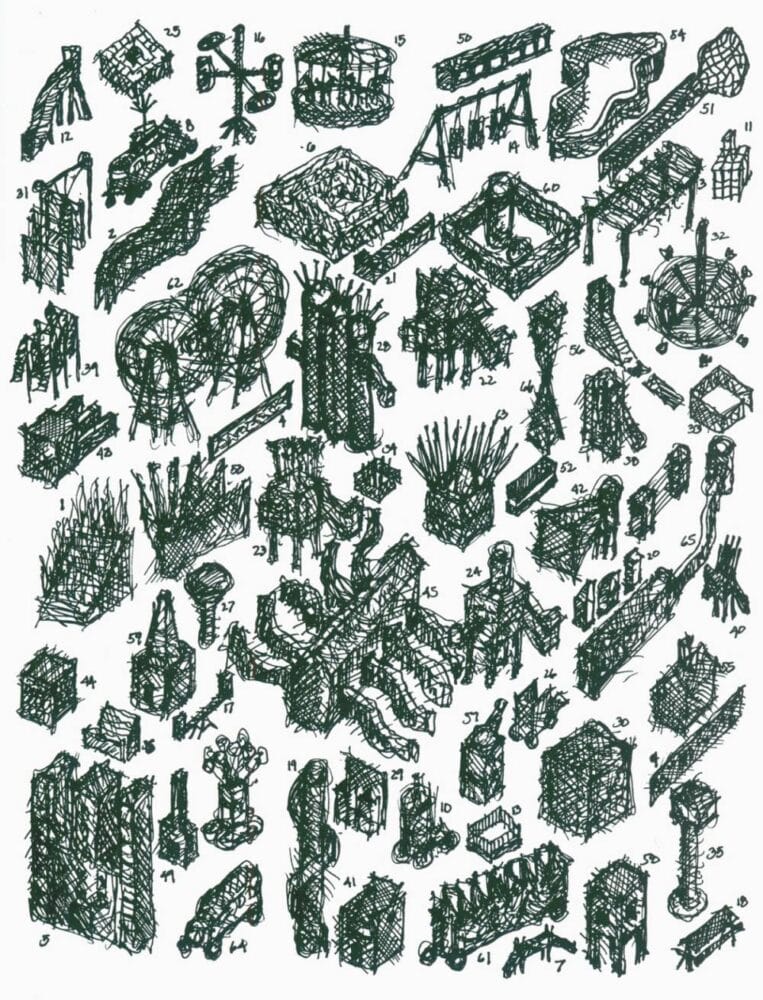
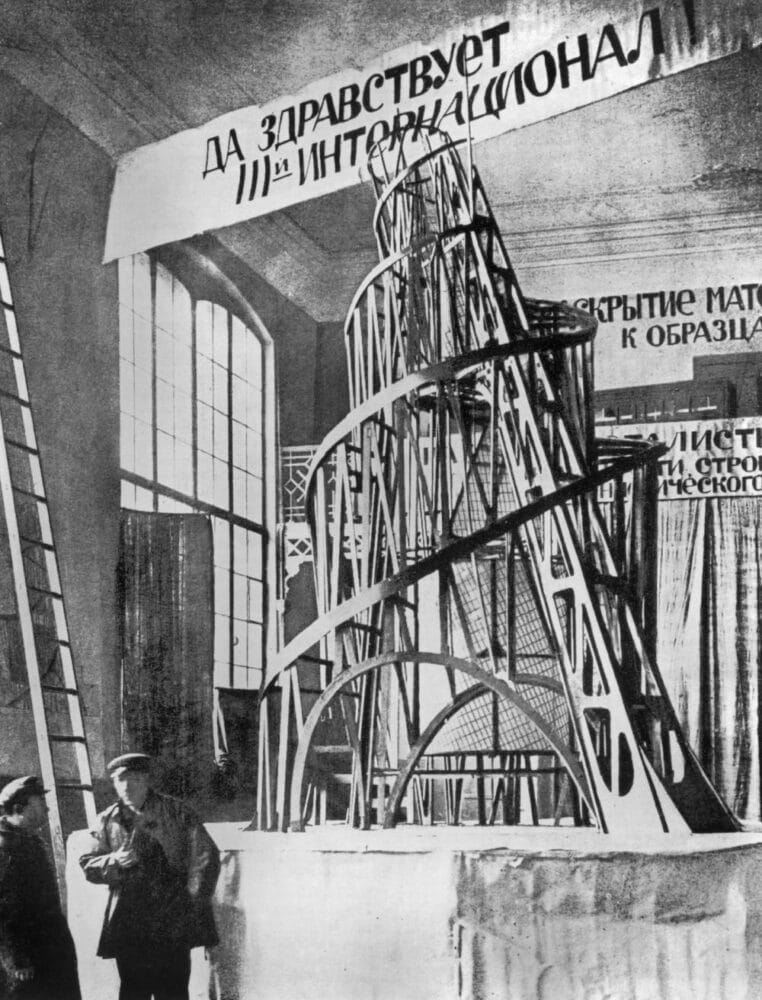
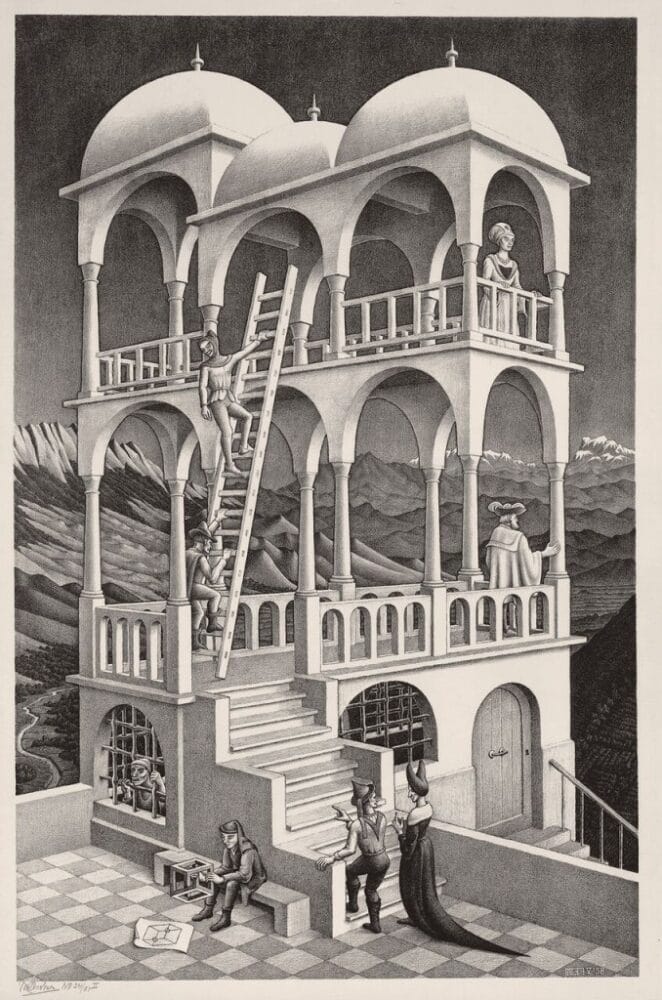
The works of John Hejduk, Vladimir Tatlin, and M.C. Escher (from left to right)
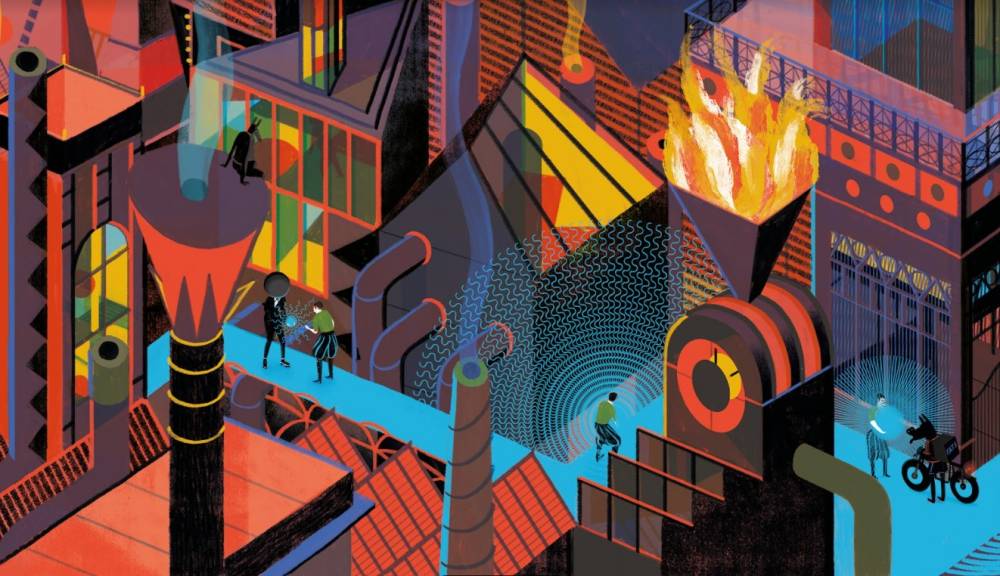
Illustration from the modern part of Lucky/Happy Hans
We then had to think of production: how would the colours reproduce in print? The book was to be printed using the offset process, which usually works with the spectrum of colours referred to as CMYK (cyan, magenta, yellow, black). But I had used what are known as special ‘spot’ colours and to ensure that their intensity was retained in the printing, we had to separate out the images into five layers (I had used five colours) before handing the files over to the press. At the press, each of the layers was made into an offset positive plate and then printed. In effect, we had to adopt a process that is usually associated with silkscreen-printing.
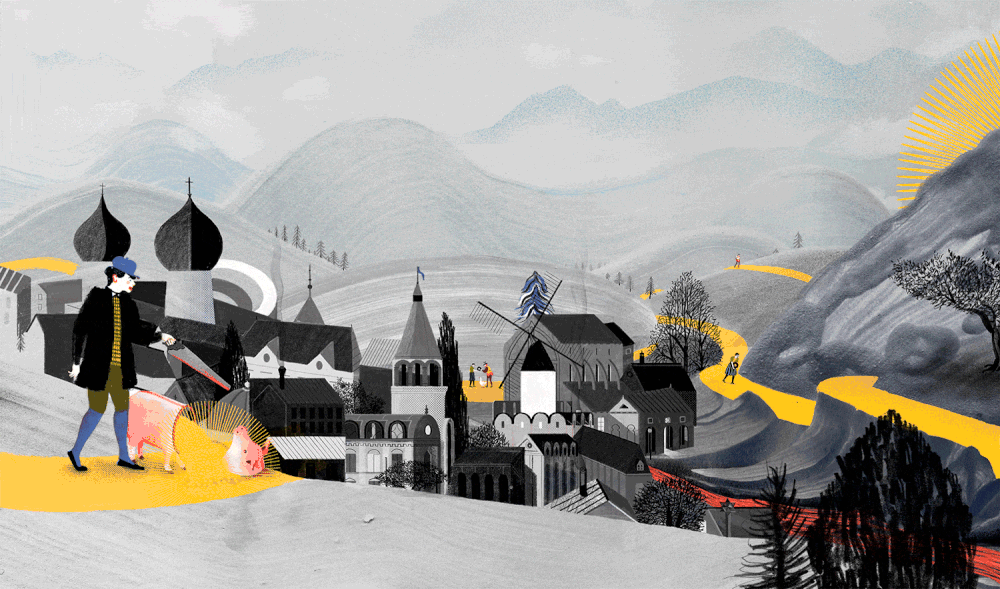
Special ‘spot’ colours used in printing Lucky/Happy Hans
And the result was worth the trouble: beautiful bright colors, which in some cases seem to have their own light. Now that the book is done and ready for its readers, let me go back to the question that I started out with: is Hans a fool as well as a sage? I think I have answered it visually, and invite you to follow the path of my rendering, and walk through mountains and valleys, dark alleys and to the edge of the city to find out what he means to you.
Maguma is the pseudonym for Spanish artist Marcos Guardiola Martín, who is based in Madrid and works for a growing number of publications, including dailies, weeklies and political journals across Europe and Latin America. Trained as an architect in Madrid, Maguma brings to his work a sense of space and surface that is unique. You can follow Maguma on Facebook, Instagram, Twitter and his website. Click here to discover his other Tara Books.


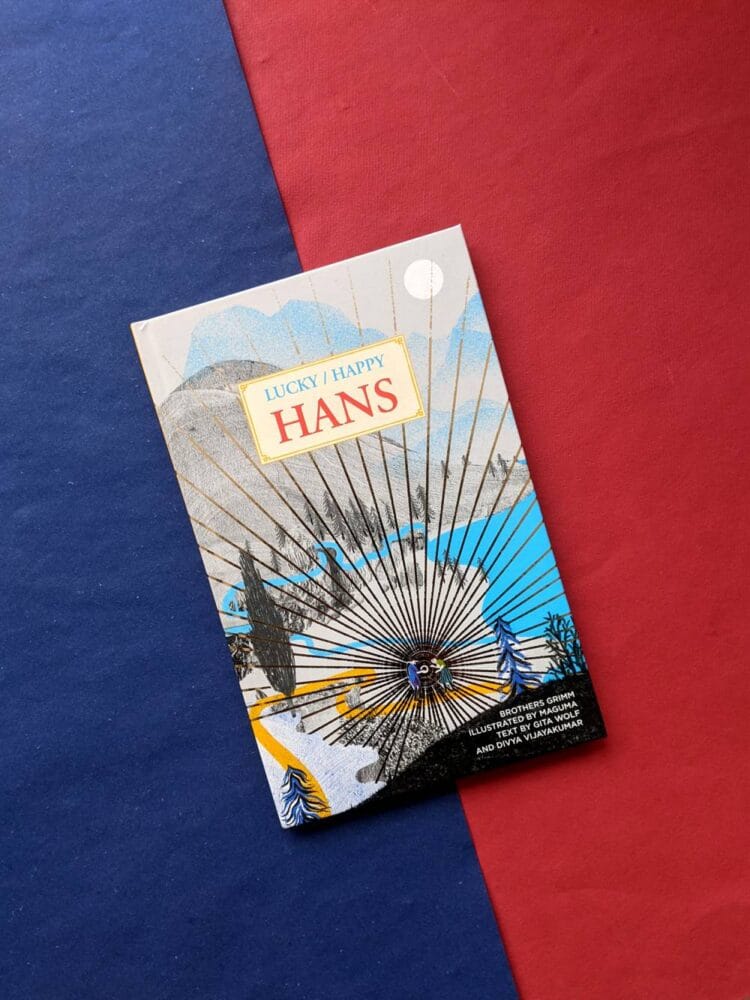
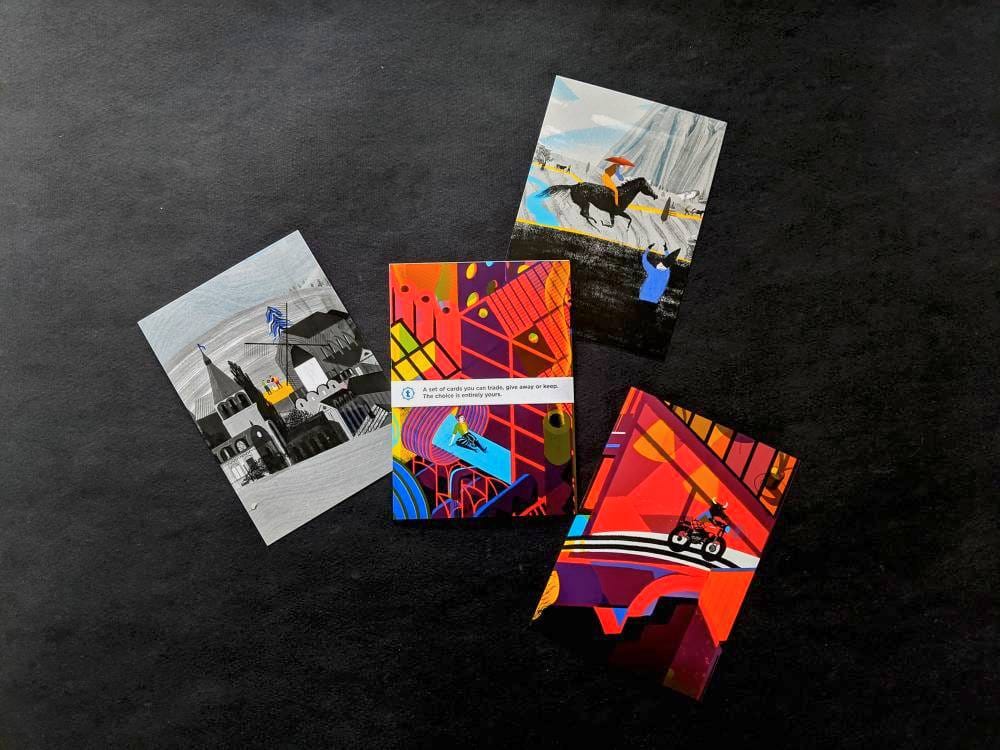

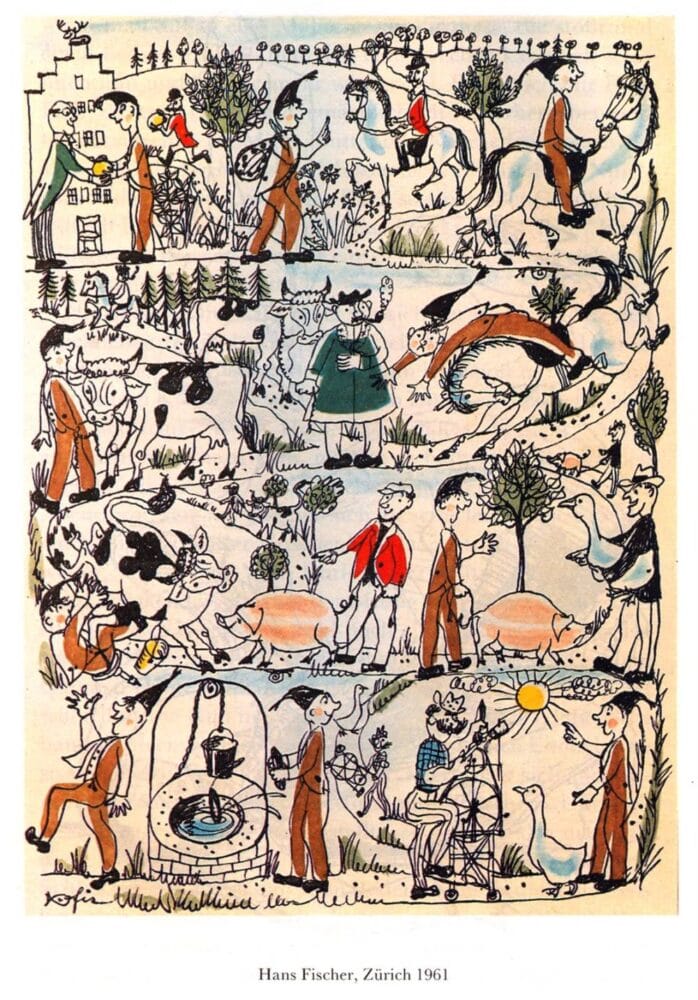
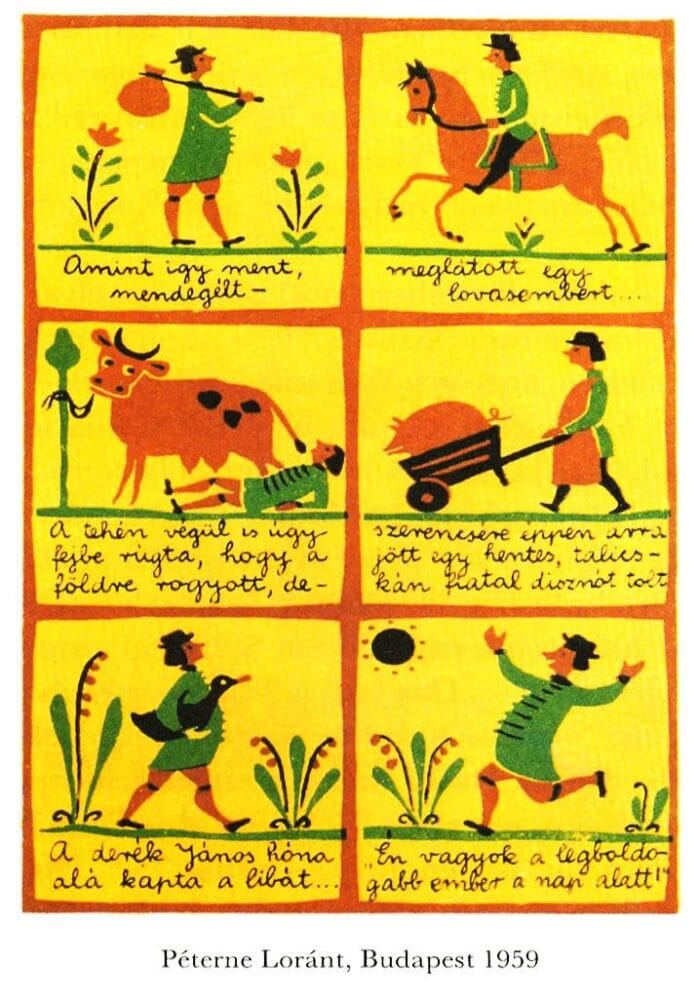
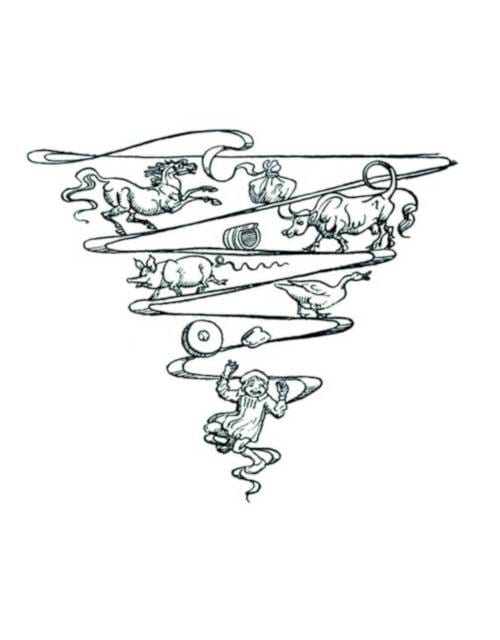
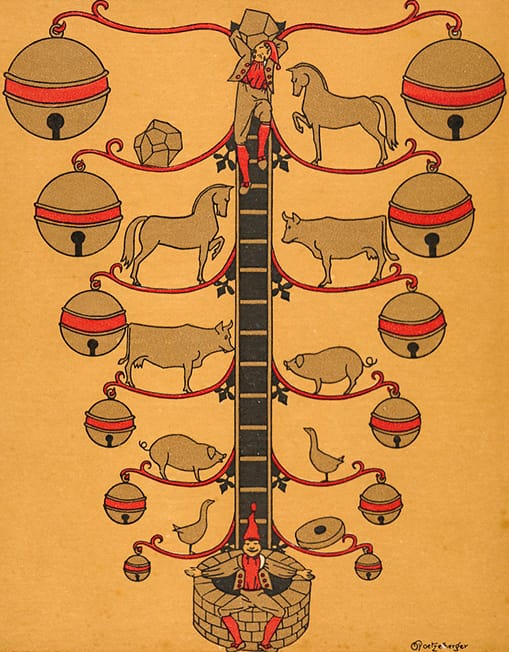

Piet Grobler
Posted at 01:54h, 04 MayBrilliant, brilliant, brilliant. One of the best picture books I have ever read.